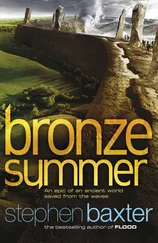Below him, the Earth closed over on itself, turning into a dome littered by the blocky buildings of the base — airplanes sitting in the washed-out sun like kids” toys — and he could see the desert beyond, etched by roads, scarred by the smooth sheen of the dry lakes.
Monica saw the takeoff from the ops building.
It was a burn and a roar, as Garry bore down the runway at full thrust. His engine nozzle opened with eerie mechanical grace, and a sheet of flame shot out. There was a rumbling, and the air seemed to shake, or perhaps it was the very ground.
Then he was in the air, and receding quickly, the flame becoming little more than a red dot. She watched until she had lost him, in the blur of the volcanic sky.
Then she went indoors, wondering how much more of this marrow-sucking heat she could withstand.
The doctors said she had a full house of mets now: secondary sites, lungs, and liver… She knew what to expect. The pressure in her skull was giving her the headaches. She might get speech or movement disorders, or epilepsy. Maybe even dementia, if she lasted so long. But the liver or lung stuff would probably collapse on her first.
The only good thing about her illness, she was finding, was that it took her mind off her worry about her son, the fighter pilot.
Aviate, navigate, communicate.
Jake checked his relative position by radar. Two is tied. Two is visual.
Garry craned his neck; he could see Jake’s bird in the muddy sky. “Clear to rejoin.”
The wing man came skimming in, sliding through the air until he was in fingertip formation, within five feet or so of Garry’s wing tip, every detail of his bird visible sharp and clear. They ran an eyeball leak and panel check of each other’s planes, and then they slid apart to a standard formation, tactical line abreast, a mile and a half apart.
Garry was sitting at the front of his plane, cushioned by ear plugs and ear cuff pads, surrounded by a crystal clear bubble of plastic. He was in a cocoon of sunlight and sound, everything at his fingertips and under his control, at home.
Garry turned the formation to the north-east, towards Arizona.
They flew over Las Vegas. The city was a splash of glass and concrete in the middle of a crumpled, arid landscape. He could see the pyramid of Luxor shining in the washed-out sun, utterly unreal. And then over Lake Mead and the Hoover Dam, and across the Shivwits Plateau… And now, here was his first, thrilling glimpse of the Grand Canyon.
Here at its western end the Canyon was a knife-gouge in the Colorado plateau. He was flying east now, into the low sun, and he could see how the light picked out sedimentary strata. In the deepest section of the Canyon he could see the Colorado River itself, a stripe of silver-blue painted over the land. There was a greenish stubble over the plateau and the upper slopes of the Canyon, the asparagus green a strong contrast to the crisp red of the old rocks exposed beneath. The stubble was a covering of trees, he knew, junipers in a sea of sage, diminished to specks by the scale of the Canyon.
He dipped low, and imagined the sound of his passing washing over the empty land. But a soft warning from Jake made him lift his nose, and gain a little more altitude. A smudge of volcanic shit, ash and dust, covered the ground here, emanating from the cracks that had opened up in million-year-old vents. Best to keep his engine intakes clear of that.
He looked into the Inner Gorge, the oldest rocks. He could see where the Moonseed was eating into them, silvery patches like scars amid the volcanism.
They headed further east. He passed Lava Falls, where rapids turned the river white, and he was flying over the Havasupai Reservation, the home of the People of Blue Green Water, who had lived here for a thousand years. But today, of course, the People had been evacuated. Despite the peril they had stuck to their traditions; they had insisted on walking out, all the way to Tusayan.
They flew on over the tourist areas around Tusayan. He could make out the tiny, scattered towns and lodges, the dusty trails along the South Rim, the fine black lines of the metalled roads. And then he followed the Colorado to the north, skirting the Navajo Reservation, soaring over Marble Canyon, until he reached Lake Powell itself.
Lake Powell was flat, like some kind of engine oil spilled into the valley, its Mediterranean blue a striking contrast with the sunlit red and ochre of the high desert. He could see at a glance the lake wasn’t natural. Its shoreline was sharply ragged, like a fractal pattern: no time for erosion to smooth away the edges here.
Maybe some day — if the kooks, like Alfred Synge, that his mother used to bring home had been right — Mars would look like this. Terraformed, by American hands and energy and ingenuity, blue against the red dust. He grinned. Even if all we do with the world we build is put up plastic pyramids.
Anyhow, today the Moonseed was soon going to find out just what Americans were capable of. For better or worse, for them all.
He turned away from the sun, with Jake on his tail. He scooted low over Lake Powell.
And there, at last, was Glen Canyon Dam. The target.
Garry was going in first. “Target in sight. Ten seconds to the drop.”
Copy, Garry. Your pickle is hot.
“Master Arm on…”
The LANTIRN targeting pod, fixed to the forward fuselage of the airplane, fired a short laser burst at the dam, to establish the range to target. A grainy image on his head-up display, generated by the pod, told him what was going on.
The time-to-drop clock counted down to zero.
The two bombs fell away from his wing pylons. They lit up and accelerated away quickly.
When the bombs were fifteen seconds from impact, Garry fired his guidance laser at the base of the dam, as close as he could get to the water line. A clock in the multi-function display counted down to zero.
He could see the missiles slam into the face of the dam: small puffs of masonry dust, in utter silence.
After that, nothing.
He peeled around, and stood off as Jake completed his own run.
The bombs were “Deep Throat” penetrator bombs, officially designated GBU-28/B, complete with Paveway laser guidance kits. The first of these babies — improvised from old, rusting Howitzer gun barrels — had been put together by Lockheed in haste in the build-up to Desert Storm, to dig out Iraqi command and control bunkers.
When all four bombs were emplaced, their tail-mounted fuses caused them to detonate, simultaneously.
It happened in an instant.
Concrete erupted from the face of the dam, hailing over the water of the Lake, which turned white. Garry imagined a shear wave slamming into the structure of the dam, weakening it fatally.
The first cracks appeared, even as he watched.
Jake whooped. “We’re the new dam-busters, boy!”
They turned into CAP — “combat air patrol” — even though they weren’t on combat duty today; they’d trace a series of long, skinny ovals in the sky, like following invisible racecourse tracks, while the camera pods they carried recorded the results of their handiwork.
It wasn’t particularly usual for a pilot to do his own follow-up spotting like this. But then, this wasn’t a usual mission. There were no hostiles. But the sky was full of volcanic shit, which nobody was quite sure of what it would do to the airplanes” engines, and so there was a reluctance to risk launching off more guys than necessary.
All of which meant, Garry thought wryly, that all of the risk today was being bought by himself and his wing man.
But he patiently settled into his ovals, each of them taking fifteen or twenty minutes, scooting over the tortured scenery of the Grand Canyon. It was no big deal. He was comfortable here, in this armchair in the sky, with the world’s greatest view; he could do this all day, or at least until he had to take a dip, a refuel, on the airborne tanker, the big 707 they had lined up on the ground.
Читать дальше
Конец ознакомительного отрывка
Купить книгу












